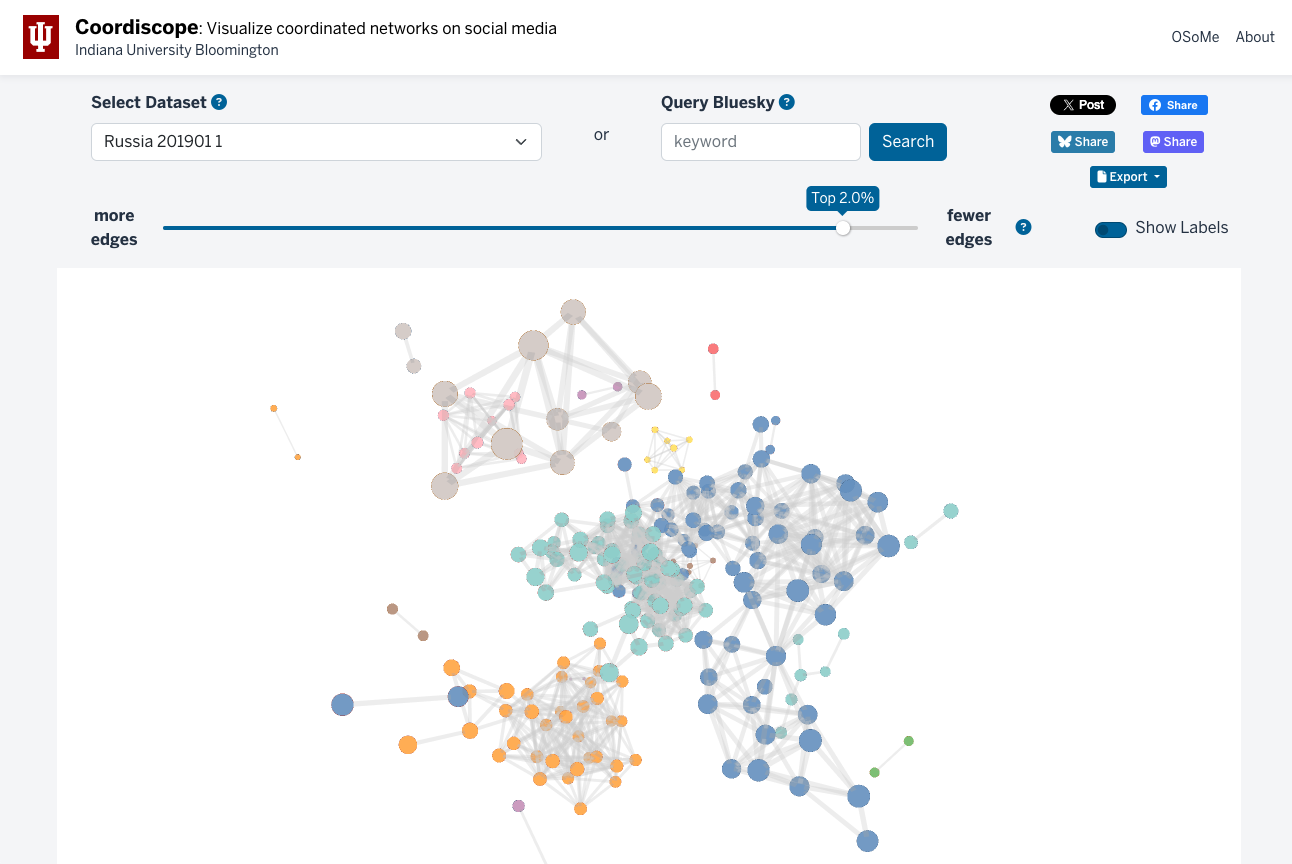Exploring the Latest OSoMe Tools
The Observatory on Social Media (OSoMe, pronounced “awesome”) is excited to introduce five new tools that will enhance the public’s ability to analyze and attend to the complexities of online information ecosystems: Coordiscope, Botometer X, Hoaxy2, OSoMe Mastodon Search, and Facebook News Bridge.
Coordiscope is a web tool designed to detect and visualize inauthentic coordinated behavior on social media. Coordiscope uses the Behavioral Language for Online Classification (BLOC) and the Helios Web visualization library, both developed at OSoMe, to compare the behavior of social media accounts. BLOC represents account behaviors through “words” that denote sequences of actions and content. Accounts with suspiciously similar behaviors are visualized as colored clusters within a network, making it easy to identify potential information operations. Coordiscope draws cases from the Twitter Moderation Research Consortium’s information operation datasets. These include coordinated influence campaigns from 17 different countries, comprising over 200 million posts. Alternatively, users can query and visualize real-time data from Bluesky.
Botometer X replaces the original Botometer website, which calculated the likelihood that a Twitter account was automated – a so-called social bot. Botometer served hundreds of thousands of queries daily, but was disabled after Twitter (now X) suspended free access to their data for researchers. Unlike the original Botometer, which fetched data from Twitter and calculated bot scores on the fly, Botometer X relies on a historical archive of over a billion pre-calculated scores. This means that no records exist about accounts created after May 31, 2023, when Twitter ended its free API. Even for accounts created earlier, Botometer X does not have a complete or representative coverage of Twitter users and does not reflect recent account activities. Botometer X is also accessible via a new endpoint of the Botometer Pro API, allowing users to fetch bot scores in batches. A Python library helps researchers interact with the API.
Hoaxy2 is an updated version of the Hoaxy tool, which was used by fact-checkers around the world to visualize temporal and network aspects of the spread of information online, as well as amplification by social bots. Each node in the network represents an account and two nodes are connected if a post is passed between the two. The color of a connection indicates the type of post: reposts, replies, quotes, or mentions. Users can interact with the visualizations, zooming in and clicking for detailed information. Since the free Twitter API was disabled, paid subscribers can now input their own API keys and real-time search was restored through the Bluesky API. While many of the functionalities that were available in the original version of Hoaxy are still operational, Hoaxy no longer provides bot scores, which relied on the Twitter API.
OSoMe Mastodon Search provides a Web interface to collect data from Mastodon, a growing federated social media platform. While Mastodon data is distributed across many individual servers (so-called “instances”), the tool makes it easy to search content by keywords and hashtags across multiple instances. Users can retrieve statuses, explore accounts, access hashtag metadata, discover Mastodon instances, and examine comprehensive documentation.
Facebook News Bridge is a browser extension utilizing a customized generative AI model to identify low-credibility posts on Facebook and generate thoughtful responses aimed at bridging political divides. As users scroll through their Facebook feed, the extension identifies posts containing links to untrustworthy sources and analyzes these posts for potential misinformation. By referencing a reliable news database updated every two hours, the extension determines whether the content is likely false. If so, users are given the option to generate an informed and relevant response that can be shared with the original poster.
All of these tools are now freely available on the OSoMe website. They are developed with partial support from Knight Foundation, DARPA, Open Technology Fund, Volkswagen Foundation, and the Civic Health Project.

